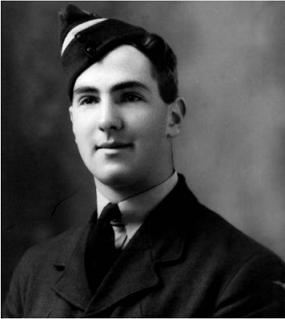
Life at No. 1 Initial Training School at Somers on Westernport Bay was very different from living at home. After David’s temporary stint in the army, sleeping in a tent with five others was not a new experience. But being woken by the sound of the bugle playing ‘Reveille’ was very different from an alarm clock chirring. The new intake quickly learned the refrain Oh how I hate to get up in the morning, singing with particular gusto the line threatening revenge on the pup who woke the bugler up! They also relished the old services saying, ‘Who called the cook a bastard?’, and its reply, ‘Who called the bastard a cook?’
The training program provided an introduction to the knowledge and skills needed to become aircrew, as distinct from ground crew. With its regimen and discipline, it also aimed to change 800 free-spirited youthful individuals into three cohesive units who identified themselves as
David, 20, being presented with his Wings,
Passing Out Parade, Point Cook, 1943
members of Australia’s armed forces, trained to obey orders instantly, without question. Personal identity was submerged under name, rank and number. David became Mattingley, C.D. Aircraftman Class 2, 408458, RAAF.
Each airman was fitted with clothing from the skin outwards - underpants, singlets, shirts, tie, socks, shoes and boots. Only pyjamas were not issued. ‘So we’re expected to sleep in the raw!’ they joked. Full uniform had to be worn at all times, even when on leave. This included the field service cap, with its coveted white flash denoting aircrew trainee status. On the station, long-sleeved overalls, known as goonskins, and jumper and beret, all blue, were to be worn in cold weather; khaki shorts and shirt in summer. Kit included blankets, towels, razor blades, shoe-cleaning gear, clothes brush and cutlery. Each man also received a sewing kit, essential for sewing the badges of rank onto his uniform. David’s unit had only to stitch on the Australia eagle.
‘Ouch! Wish Mum could do this,’ they exclaimed, sucking pricked fingers.
Finally, each received a kitbag in which to keep everything, and out of which he would live.
After inspection of tents, kit, uniform, and a full parade, the day began in earnest with a solid timetable of drill and classes. More slogging away at maths and physics, more morse code and aircraft recognition. But now there were new subjects: Air Force law, meteorology, armaments and ship recognition, popularly called shipwreck.
David had always been interested in weather, especially cloud formations which were such an integral part of Tasmanian days, and he became absorbed in the detail and variety of patterns to be learnt and understood if he was to fly safely. Cumulonimbus thunderheads were

David, RAAF Aircraftman Class 2 White flash on cap denotes aircrew trainee status
always to be avoided and cumulus clouds treated with caution, because of the turbulence they caused.
Armaments were another matter. David had to grapple with the thought of being the agent of delivery for loads of bombs. The prospect of using weapons against fellow human beings was not a happy one. But news from the theatres of war did not allow for personal scruples. The German army was advancing steadily across Russia and by late August had reached Stalingrad, while Japan had already become a major threat to Australia itself with the fall of Singapore. So David learned to strip and assemble both Vickers and Browning machine guns and Smith and Wesson revolvers.
The RAF had stepped up attacks on German ports with a 1000 bomber raid on Bremen in June, followed by a raid on Hamburg in July. But British convoys to Malta had suffered heavy losses, not only of merchant shipping but also Royal Navy (RN) escorts. So shipwreck was very important. Ships had to be recognised from above as well as in profile. Not just RAN and RN, but also German, Italian and Japanese - battleships, cruisers, aircraft carriers, destroyers, corvettes. Merchant ships and tankers too. And national markings. David’s brain teemed with images.
In aircraft recognition, flash cards, projected images and suspended models were used to familiarise students with silhouettes from every likely angle. RAF and Luftwaffe fighters and bombers were shown from above, below, sideways, head on, and turning - Spitfires, Hurricanes, Blenheims and Wellingtons, Messerschmitts, Junkers, Heinkels, Dorniers and almost 150 others, including Japanese planes.
David studied the outlines and distinguishing features. Then he drew the planes and ships over, over, over again until they were indelibly imprinted in his mind and he could pass the weekly tests with scarcely an error.
Drill, marching and physical training before lunch provided a welcome break from concentrated study. The recruits moaned about the weekly cross-country run, but gradually everyone grew fitter and tougher, losing puppy fat or flab.
Daily duties included kitchen work, cleaning latrines and guard duties. Fatigue, punishment for small misdemeanours such as being late on parade, meant extra latrine cleaning or kitchen work.
One day, David and his companion were on guard duty when a carload of girls became bogged in the sandy track nearby. In reward for their gallantry in digging out the car, the girls gave them each an enamel mug full of sherry! The boys were lucky to escape punishment.
At dinner, everyone was also hungry for the mail which was distributed, eager for news from home. The big moment when ‘the eagle shat’ came once a fortnight at pay parade, and each man received four pounds and four shillings - six shillings per day. Sunday morning church parade was compulsory. If they had Saturday leave, David and other Tasmanians, school friend Peter Lord, summer holiday companion Tas Williams, and Ian Vickers, also from Launceston, would catch bus then train to Melbourne, to see the sights, window-shop or take a tram ride. Often they went to the cinema to see British films with war themes. They were riveted by Coastal Command, seeing in action Sunderland and Catalina flying boats and others they had studied so closely in aircraft rec. The bittersweet wartime romance Mrs Miniver had many in the audience in tears. But camp life did not provide opportunities for forming attachments, and although David wrote to various friends, he did not have a regular girlfriend. His heart was fully committed to the world of flying.
As the two units ahead completed the course and graduated, David’s group counted the weeks until their passing out parade. In the intake after his, David met a staff member from his school who was struggling with some of the subjects and he found himself in the unexpected role of tutor to his former teacher. A natural teacher himself, David also helped other trainees struggling with their studies.
After four months and final examinations, David’s unit completed their initial training and graduated with the rank of Leading Aircraftman. They anxiously awaited mustering, as the allocation to specific aircrew roles was known. Their abilities had been carefully assessed and after yet another interview each was assigned to further training either as pilot, navigator, wireless operator or air gunner. It was a tense time because everyone wanted to be selected as a pilot. Many had their hopes dashed as they found themselves scrubbed, their names not on the coveted list. Some of David’s friends were sent off to specialised courses in different parts of Australia and he wondered if he would ever see them again. David was elated to find his name on the list for pilot training. He was fulfilling his dream.
On 15 October, those selected to be pilots were posted to their Elementary Flying Training Schools (EFTS). David was thrilled to be sent to No. 7 EFTS at Western Junction. The next three months were to be some of the happiest he had ever known. The morning after they arrived, an instructor said, ‘Mattingley, I’m taking you on a familiarisation flight. You’ll be learning on the only vice-free plane I know.’ Walking out across the grass beside this experienced pilot past the line of training Moths, David, heart alight with excitement, felt as if a thousand moths were fluttering around it. They stopped beside the last Tiger Moth and he watched and listened attentively as the instructor did the pre-flight check, dropped the low
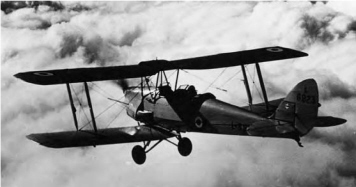
Tiger Moth, used on Elementary Flying Training School courses
door to the cockpit and said, ‘Hop in.’ David took a deep breath. This was it!
Just one foot after the other on the footholds and he was in, sitting in the rear, strapping himself in under the instructor’s watchful eye. David observed over the instructor’s shoulder as the instructor checked the controls. The mechanic swung the two-bladed propeller until the engine fired. The instructor checked the engine revs on each magneto.
‘All set. Off we go,’ he said through the speaking tube.
The little Moth taxied across the grass and turned into wind. As the pilot opened the throttle it moved slowly at first, then gradually increased speed. Almost imperceptibly it lifted and they were airborne. Heading into the blue sky. They cleared the hedge at the end of the airfield as the plane gained height. Up, up and away towards the Western Tiers, which lay like a purple scarf on the horizon. Below, the landscape shone in the spring sunlight. It was David’s beloved Tasmania at its loveliest. Green fields pinpointed yellow by clumps of double daffodils, and smudged pearly pink by blossom of ancient apple trees where early settlers’ cottages had once stood. Pastures with sheep scattered like grains of rice interspersed with the rich brown corduroy of ploughed paddocks. All linked and overlaid with a network of hawthorn hedges in frothing white spring flower.
The wind whistled in the wires, the engine throbbed sweetly and steadily. At 3000 feet in the open cockpit, David was glad of the goggles, gauntlets and leather helmet he had been issued, and the heavy overalls buttoned at the wrist to keep out the wind.
All too soon the instructor was turning the plane back towards Western Junction. David gazed across at the rolling cumulus clouds topping the chunky forms of Mount Arthur, Mount Barrow and Ben Lomond like clotted cream, and down on the winding course of the South Esk River, glinting through the tender tracery of willows. This was a day he would never forget.
For days after that first take-off and touchdown David felt the exhilaration of his first flight. But although his heart was in the clouds, his head certainly was not. The new course demanded concentration and hard work, with more crucial new subjects to master: airmanship,
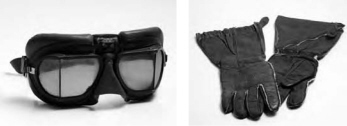
Flying goggles and gauntlets, standard RAF issue
theory of flight, navigation and technical details, aircraft construction - airframes and engines. A pilot was expected to understand everything about the plane he flew. So David learned every part of the Tiger Moth and how it functioned, and studied some of the more sophisticated aircraft he would fly later. Night after night he sat on his bed studying, determined to do well in the final exams.
Flying lessons were the highlight of each day and he awaited his slots eagerly. They were always at different times to allow each trainee to experience varying conditions. After the initial flight as a passenger, for the first week all were with an instructor, practising take-off into wind, powered approach and gliding.
Then, at the beginning of November, David went solo for the first time. It was one of the most momentous days of his life, walking across the dewy grass, knowing that he and he alone was responsible for the safety of the little Tiger Moth which meant so much to him. And for his own life. Heart thumping, he went through the pre-flight safety check with utmost care, climbed aboard and strapped himself in. The mechanic swung the propeller, the engine fired, David signalled ‘Chocks away’, and under his control the Moth moved forward into the wind and took off.
There was no time to be nervous. He had to perform a set exercise in only fifteen minutes. Tense with concentration, David performed all the actions he had practised with the instructor. He watched the horizon and the instruments. Almost before he knew it, it was time to return. Checking the windsock he took the downwind leg, then the shorter cross-wind and turned into the final approach. Throttling back the engine, he lost height to bring the Moth in to land. There was a rumble as wheels and tailskid touched down. Adrenalin still pumping, he taxied back, uncomfortably aware that a Tiger Moth has no brakes. Finally the Moth came to a stop. He switched off, clambered out and took a deep breath of the bright morning air. David had completed his first solo.
Over the next four weeks he made forty-five flights, totalling sixty hours, half of them solo. He learned to recover from spins, to sideslip and to do climbing turns and steep turns. David loved the cross-country facet of training. He particularly enjoyed navigating visually over predetermined courses, identifying landmarks - railways, rivers and towns. He practised precautionary and forced landings, and learned to fly at night entirely by instruments.
The altimeter in the Moth did not register small changes in altitude. Soon after take-off one night he was shaken to find that having crossed two hedges and the road between, his wheels were touching the rising ground beyond. He immediately eased back the joystick and opened the throttle fully. To his relief the Moth climbed away instantly. It was a valuable experience, proving that the Tiger Moth was ideal for training because it was so forgiving of beginners’ mistakes.
As the young pilots became more proficient, aerobatics, a special thrill, were a regular part of training. They learned to loop and roll and do stall turns, which could be a useful manoeuvre in a tight situation. They learned the truth of the saying, ‘There are old pilots and bold pilots. But there are no old and bold pilots.’ And they were certainly not encouraged to emulate the instructor who flew David between a pair of lofty poplar trees!
David was sorry when the course drew near to its close in December. Western Junction, with permanent hutments and only 50 trainees, had been quite intimate, much more congenial than Somers. With good meals and plenty of Tasmanian beef, potatoes and salad, WJ was almost like a big family, with lots of larks and teasing.
When David found a slug in his lettuce, a mate dared him, ‘Bet you can’t eat that!’ Not to be beaten, he dropped it in his tea and downed it. He was never fond of tea after that. David looked forward to spending weekend leaves at home picking raspberries and strawberries, slug-free, and tucking into his mother’s gooseberry pies.
One event stood out during this time. The trainees never forgot their first street march. Rising early, they boarded the train for the long trip to Hobart, laughing and joking like school-children on an outing, enjoying the break from routine. At the station they formed up for the march through the capital. One of the tallest, David was in the front rank. At midday they stepped out to the sound of an army band. It was a chill grey day with a keen wind off Mount Wellington, which stood like a sentinel above the city.
To their amazement, the streets were lined, not just with Christmas shoppers and the idly curious, but with families, school groups, shop assistants and office workers on their lunch break, even hospital patients with their nurses. Country families had left their cows or tractors or apple trees. Even the wharves were empty as fishermen deserted their boats. Everyone was hoping to catch a glimpse of a son or a brother, an old school friend or the boy from across the road. Johnny, Jack or Jim. People from near and far turned out to honour these young men who would soon be going to war in some distant place.
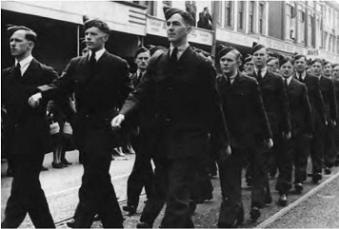
Leading the street march, Hobart, 1942
‘Good on ya, Johnny.’
‘Good one, Bill. Give it to those Huns.’
‘Teach those Japs a lesson.’
There were bursts of clapping, bursts of cheering. Sometimes there was stifled sobbing, sometimes a fluttering hanky or flag. But for the most part the crowd was silent. Awed by the solemnity of the occasion, the sight of fifty of their finest - sons of farmers, fishermen, factory workers, doctors, dentists, bankers, builders - all prepared to lay down their lives.
The men’s expressions were serious as they concentrated on keeping in step along the tram lines, while the trams waited by the GPO, whose clock boomed the hour. More conscious than ever of the honour and the responsibility that the dark blue uniform laid on them, binding them together as brothers, in loyalty, discipline and duty. Some of them - no one knew who - would be called to the ultimate sacrifice for king and country. They marched erect, their bearing reflecting this knowledge, this pride.
It was a silent journey back, each man immersed in his own thoughts, wrapped in his own memories, grappling with his own fears. Sunlight shafted across the Midland paddocks, the Western Tiers loomed purple against the sunset which gilded the clouds as the milestone day drew to its close.
Towards the course’s conclusion David was assessed as an above-average pilot. Trainees were asked if they would prefer to continue their training in single-engined or multi-engined planes. Like most others, David dreamed of being a fighter pilot in singles, perhaps in Spitfires in Britain, Hurricanes in North Africa or Kittyhawks in New Guinea. But because of the high casualty rate in bombers, RAF Bomber Command needed more pilots. So his next posting was back to Victoria to No. 1 Service Flying Training School at Point Cook to learn to fly multis. After what was to be his last Christmas home for four years, David and his fellow trainee pilots boarded the Nairana again for the overnight crossing of Bass Strait.
Point Cook, established in 1914 in Australian flying’s infancy, was the Air Force’s oldest base. On Port Phillip Bay, in flat terrain between Melbourne and Geelong, its site had been chosen for proximity to both rail and port. After Western Junction’s friendly atmosphere, it was a surprise to find other attitudes here, with some condescension shown towards the newcomers. A peacetime station for so long, Point Cook had become focused more on administration than action, and the wartime trainees had quickly coined a phrase passed on to each intake - ‘Chairborne versus Airborne’.
The station’s permanent brick buildings were not to be used by trainees, who occupied temporary quarters. Nor did the trainees fly at Point Cook. All training flights took place from satellite airfields, just paddocks at Werribee, Lara and Little River. Students were transported by open truck, and the flight office was a large wooden crate. The only amenity was a Furphy cart providing tepid drinking water. It was mid-January. There was no shade or shelter for the young airmen, and the planes, made of wood and plywood, sat out in the sun all day, and were blisteringly hot when on the ground. They were Oxfords, twin-engined monoplanes, more than twice the size of the single-engined biplane Tiger Moths. The landscape, too, was very different. After Tasmania’s spring and early summer verdure, rivers and purple mountains, the expanse of sunburnt brown paddocks shimmering in the heat, windswept and treeless, was a shock and the glare was much harder on the eyes.
Unlike the Tiger Moth’s tandem seating, the instructor and trainee sat side by side in the Oxford. David concentrated hard as the instructor explained the instrument panel, far more complex than the Moth’s, and rehearsed the vital actions before take-off, after takeoff, before landing and after landing. There was a lot to learn. Then after the instructor had trimmed elevators and rudders, selected fuel tanks, checked their gauges and cocks, checked flaps and uncaged the gyro which operated the compass, it was the moment for take-off. Each engine was three times as powerful as the Moth’s.
David felt the acceleration and found himself looking down on the dry brown plain unrolling ahead, with the
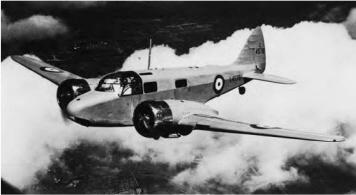
Airspeed Oxford, twin-engined trainer used at Point Cook and in the UK
You Yangs low and mauve-blue to the north and Port Phillip Bay flat and grey-blue to the south. The instructor demonstrated climbing, gliding, stalling and turning, and flying and turning with only one engine, before bringing the Oxford in to land.
Early in the course, the airmen learned a chilling lesson, vital for survival - how to abandon an aircraft.
‘Hope we never have to do that,’ each man whispered to himself.
There was also the usual full timetable of lectures with new subjects. These included more advanced navigation with some astronomy and knowledge of astro-nav, navigation by the stars. They also had to plot courses on paper as far as Gippsland and the Bass Strait islands. Other subjects included armaments - gunnery, pyrotechnics, bombs and their components (known as bombs and comps) - and Aldis lamp signalling from air to ground.
As they had at Western Junction, the trainees also spent many hours in the Link Trainer, a primitive precursor of the modern flight simulator. Two days after his familiarisation flight, David went on his first solo in an Oxford and by the end of January had tallied 12 hours flying. Then he did his first cross-country lasting two hours. Each was longer than the last, extending into Victoria’s Western District.
Night flying was another challenge. The flights lasted up to an hour, and included both instrument flying and some astro-nav. David loved the clear starry nights with the Southern Cross in different positions. But like everyone, he was deeply shocked when a fellow trainee was killed in a crash on a night flying exercise. It was a sobering realisation of the cost of pilot error.
That night boys became men.
In the weeks that followed, the trainees practised precautionary and forced landings on one engine, and low flying was introduced, which David found fun. He enjoyed following the tops of cumulus cloud banks, though on one occasion he was startled to find another Oxford doing the same thing, a bit too close for safety. Formation flying was the next challenge. It required intense concentration and kept the adrenalin flowing.
Stringent revision flights in late March preceded a major test, which examined general proficiency before a pilot was awarded his Wings. An exercise in naval cooperation tested the nerves when David was required to fly his Oxford over Flinders Naval Base as a practice target for ground-based gun crews. He could see the gunners elevating and traversing their anti-aircraft guns, aiming at him, and was thankful they were not firing live ammunition. ‘But we will be the target one day,’ he told himself.
In Europe, the air war had intensified. The German air attack on London, renewed in January, had been followed by a heavy RAF raid on Berlin. In March the RAF began systematic bombing of the European railway network. So in April when bombing became the next part of the Point Cook training, every man was in no doubt of its importance and the need to become proficient.
Flying in pairs, each took a turn as pilot, then bomb aimer. It was simulated bombing, with a camera focused on a ground target. It was the pilot’s responsibility to bring the plane accurately into position so that the bomb aimer could press the tit (the button which would release the bombs on real operations) when the sights were correctly aligned on target. Results were recorded photographically and assessed later. An inaccurate pilot might result in inefficient bombing.
Even as these young Australian pilots trained, the RAF commenced heavy raids on Germany’s industrial heartland, the Ruhr Valley, climaxing in the legendary exploits of the Dam Busters. As the air offensive on Germany became ever more destructive, David’s course was coming to a close, culminating in a solid week of formation flying with some air to ground radio telephony.
On 21 May 1943, with a total of 182 flying hours, he was presented with his Wings at a graduation ceremony at Point Cook, which his parents attended. At a celebratory dinner at the Hotel Australia in Melbourne, the menu, drawn up as a flight plan with typical Air Force humour, included a weather forecast: Very wet night. Depression expected tomorrow morning. Tomato juice was 90 Octane. Roast lamb was cross-country killed, and the dessert was Bombe Australia (no dummy runs permitted)!
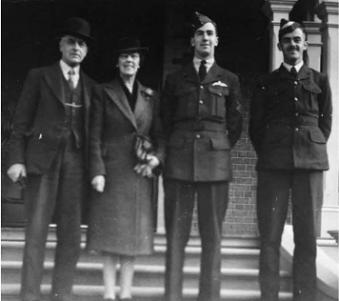
David with his parents and brother Brian at home, Launceston, 1943
When David was notified he had a week’s pre-embarkation leave, many emotions and thoughts he had pushed to the back of his mind while concentrating on training surged to the fore. He had always wanted to discover the world beyond Tasmania’s familiar shores. Opportunities, however, to travel even in Australia, let alone beyond, were rare for most people. He was fortunate and had already visited Melbourne, Adelaide, Sydney and Fiji. But he was hungry for new experiences, new insights into life in places with different histories and cultures. Although a couple of his family’s acquaintances had come as migrants to Australia, few of all the other people they knew had travelled overseas. Now, at the age of twenty, he was going abroad. Leaving behind those people and places he had known and loved, perhaps never to see them again. He was about to face challenges and dangers he could hardly begin to imagine.
Now promoted to Sergeant, David returned to Melbourne, sleeping on deck as the Nairana was overcrowded with servicemen. At No. 1 Embarkation Depot at Ascot Vale Showgrounds, he was glad to have time for one last visit to the family of Des Hadden, his friend since schooldays, who had made him so welcome on weekend leaves. Then the young airmen travelled overnight by train to No. 4 Embarkation Depot at Scotch College, Adelaide. Four days later David’s group embarked on SS Umgeni.
Would they head west? North? Or east? Were they bound for the Middle East? Or New Guinea? Or Britain? David was hoping with all his heart that Britain would be their destination.